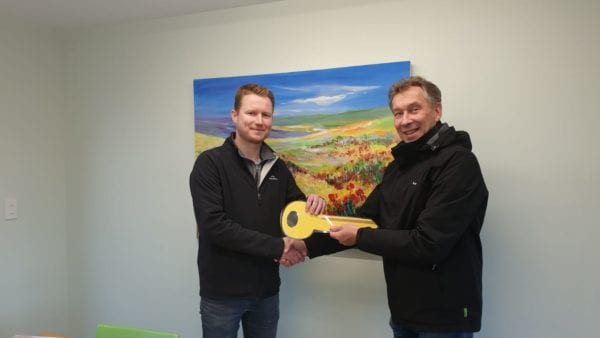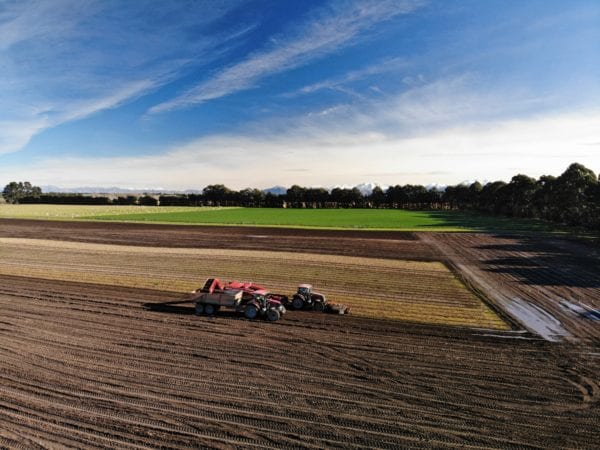In 1996, Royal Van Zanten planted her first lily bulbs in New Zealand. After 4 years, Van Zanten NZ moved to a new location on the South Island. The village of Rakaia in the Canterbury region to be exact. Our lily bulbs are grown by 2 contract growers with whom we have been working together for years. The processing, packing, preparation, storage and export of the bulbs is done by our own team of Van Zanten Flowerbulbs NZ in Rakaia. With Oceania and Asia as the largest sales market. The reason that Royal van Zanten has a location in New Zealand is to provide our customers fresh bulbs of a high quality in the months of September to March. This in addition to the available northern hemisphere lily bulbs. Since 2015, Cees Prins, General Manager, has been responsible for the entire operation in New Zealand.
Team. The New Zealand team consists of 8 permanent colleagues, a group of (New Zealand) colleagues who always return during the harvest season and a group of mainly “backpackers”. ‘The great thing about my job is to achieve our goals every season under time pressure with such a mixed team,’ says Cees. ´This is my passion and also gives me a huge drive.’ In addition to achieving the main goal: supplying healthy bulbs that are packed and stored in time, Cees also has a personal goal. That is: to give my knowledge to all employees. ‘Although New Zealand is a beautiful country to live in, the Netherlands is still my country. My goal is that by 2020 Jan Jaap Boon will replace me, here in New Zealand. Jan Jaap has been here in New Zealand with me for almost half a year, so he has plenty of time to learn. And given his experience in the sector I´m more than confident that the company is in good hands with him. New Zealand is a wonderful adventure, but it is important that the younger generation takes over. Rejuvenation is always important for gaining new insights and the continuity of the company.’

Cees (right) symbolically hands over the key to Jan Jaap (left). Jan Jaap will be in charge of the company in New Zealand in 2020
Society. In New Zealand it is common for a company to give something back to society, this is really in the culture. We have chosen to give something back to the local community of Rakaia. As a goal we support the regional Lions Club. We donate a number of bulbs to the Lions Club every year. These bulbs are sold by the members of the Lions Club and the money goes back to the local community. We are talking about an amount of 25 to 30.000 NZD, that is about 15 to 20.000 euros. ‘I am therefore very proud of the fact that Van Zanten Flowerbulbs NZ can give something back to the Rakaia community.’
Differences. Apart from the opposite growing seasons between the Netherlands and New Zealand and the differences in culture, there are even more differences between the 2 locations. 2 examples to illustrate this.
Frost control. For example, the naked scales in the Netherlands are protected against frost with a fleece. Helicopters are used to protect the crop here (in New Zealand) against frost. The helicopters mix the cold air on the ground with the warm air from above the ground.
Processing of bulbs. The order of processing bulbs is different. In New Zealand the bulbs go through the following 5 steps:
- Cleaning the bulbs by puling out the stems
- Rinsing in the export process
- Drying by the drying wall
- (Weight) counting
- After a few days the bulbs are packed and prepared for transport
In the Netherlands, however, the bulbs are first cleaned counted and then – before packing – the export bulbs are rinsed clean.
Winter planting. Within our company we grow the planting material from naked scales cultivation. We harvest and process this planting material in May and June. Due to the favorable climatic conditions in Rakaia, we can replant the planting material in our growing area in June and July. Through this “winter planting” we do not store the plant stock in our cold stores for long and we have a long growing season for the available crop.
Future. In the coming years, Royal Van Zanten will certainly continue to grow lily bulbs in New Zealand. We certainly have no plans to leave, says Cees. “Last April all drying are replaced by new walls and new fans. Of course more things will change in the future and investments will have to be made for the environment and certainly also to save labor costs. But what exactly …? That remains the future!
